|

 Angels
images in Art History: An Angelic Journey through time Angels
images in Art History: An Angelic Journey through time
Article written By artsales.com editor Chester Comstock: Edited
version appears in the Spring 2003 issue of "Sculptural Pursuit".
In the summer of 2002 I was invited by the Denver
Sculpture Society to show my art at the "Joy of Sculpture"
Exhibit, on Columbus Day weekend at the Colorado Historical Museum.
The event was a reminder of the richness of sculptural
talent that is available to those of you who have an interest in
classical art forms. As fate and the muses would have it my exhibit
at the Museum was right next to Rik Sargent’s personal exhibit,
which had a heavy focus on angel images. My personal background
and early training in the arts was steeped in art history and the
study of classical themes. The catch is when I lived in Sedona Arizona
one of my collectors an author
Don Pendleton and his wife Linda, who wrote the unforgettable
book “To
Dance with Angels”, had asked me to do an angel sculpture
for their art collection.
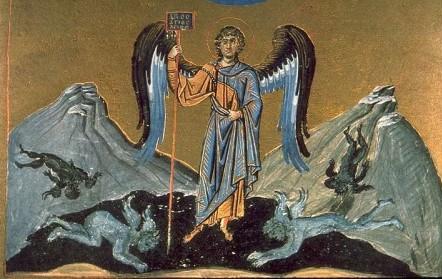
Byzantine Image of the Angel Michael 1000 AD
For those of you who do not know me, I have a
personality and mind that tends to be somewhat obsessive compulsive
in its basic make up. The effect of Don
and Linda asking me to create an angel image was I made a study
of the history of angel images, which resulted in covering the Iconography
of angel imagery from pre-dynastic Egypt to modern times and tracing
the evolution of similar themes through the far eastern cultures.
Through the years I have done many exhibits and
met thousands of people within the context of showing my art to
the public. Working in the environment of these exhibits resulted
in my coming to the conclusion and realization that a viewer’s
reactions to any given artwork are often very subjective and depend
entirely on their personal background and experience as it relates
to the art on display. Within the context of major art exhibits,
an artist’s work can be seen to be primarily a pneumonic devise
or external stimulus which stimulates the viewer’s subjective
experience while viewing the art. This concept and idea leads naturally
to the truism that artists as creators can literally transform the
experience people have within the environment in which their art
is displayed.
At the Joy of Sculpture exhibit these two axiomatic
truths were quickly to become a hard-core reality for my own personal
experience at the exhibit. For example it soon became apparent I
couldn't pass through or be in Rik Sargent’s exhibit space
without a flood of angel imagery and ideas entering my mind from
my subconscious. The net effect of Rik’s exhibit on me personally
was to trigger an outpouring of ideas which seemed to come automatically
without prompting, well at least the art seemed to be doing the
prompting. From my personal point of view the result of Rick’s
exhibit was that his sculptures brought back the memories of my
study of angel Iconography and Christian Icons. The images and ideas
flooding into my conscious mind were of concepts I had come across
during my overview study of angel iconography. It was Rik's art
that was stimulating this response from my memory.
 This
article is an attempt to share some of these memories with the readers
of this article. This
article is an attempt to share some of these memories with the readers
of this article.
To put things in chronological order, the earliest image in art
history which I could find that seems to relate strongly to our
modern Iconography of an angel was created 6000 years ago during
the Naquada period of pre-dynastic Egypt in approximately 4000 BC.
The Dancing Goddess images can be found both in
pottery and petroglyphs in the Egyptian Eastern desert next to long
established trading routes between the Red sea and the settlement
of Naquada in the Nile river valley near Luxor.
This theme, The Dancing Goddess,
in pottery clearly shows a link to an animistic version of the dancing
goddess which is a combination of a bird with a human female body.

Naqada Dancing Goddess
Pottery 4000 BCE
To Dance
With Angels
The Dancing Goddess theme with
hands over her head can also be found in the Cypro Minoan and Malta
cultures of the same historic time frame suggesting possible seafaring
trading links between the Nile River valley and the Mediterranean
island cultures.
The time frame for these seafaring links dates
to at least 2000 years before the immigration of Abraham from Ur
and at least 2500 years before the Hebrew's Biblical Exodus. This
earliest sculptural angel image is called The Dancing Goddess
and is an animistic bird goddess with her wings held above her head.
This most primal and basic imagery remained fixed within the Egyptian
culture and has evolved into several different forms in present
time.
The iconography of the Gods in Egyptian culture
nearly all had animistic origins and held strong associations with
the primal forces of nature. The female body with bird head and/or
wings evolved over time into the lexicon of feminine goddesses in
the pantheon of Egyptian Gods and Goddesses and eventually evolved
into the goddess images of Isis, and her sister Goddesses by the
middle Egyptian Culture dating to approximately 1800 BC.
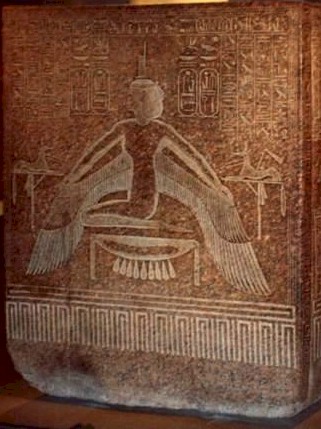
The iconography of Isis and her sister goddesses
remained the dominant goddess image in the Egyptian culture until
early Christian times, that is until about 600 CE. This means that
this imagery and its mythologies evolved over and lasted an amazing
5,000 years of the human experience.
In 1998 by chance I was ask to do an interpretation
of what the "Ark of the Covenant" may
have looked like by a pastor in Denver. My personal approach to
this problem was to put the concept of the ark into its chronological
and geographical context in art history in order to interpolate
what it may have looked like.
This project was a genuine challenge and I felt
it deserved its own thesis because of the interest level in the
subject. You can read my thesis and conclusions by using the links
in the image below and the red text links.
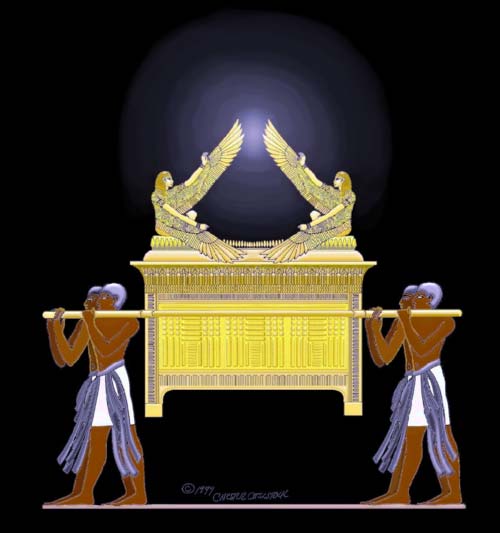
The likely appearance
of the "Ark of the Covenant" Based on its Chronological
and Geographical
placement in the evolution of Angel iconography.
Purchase
this Image as print
See Chester Comstock's thesis and research.
VIsit:
To Dance With Angels
By 875 BCE similar winged figures called “Apkallu”
could be found in the city of Nimrud in Assyria in sculptural relief
on the palace walls. The winged figures within the Egyptian culture
had been primarily of the feminine gender however the Nimrud guardian
angels were primarily male in gender.
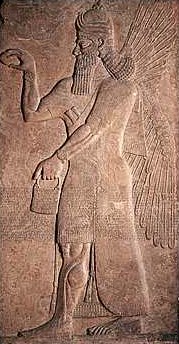
Angel of Nimrud 875 BCE

cylinder seal from Babylonia 8th century BC
image from the Peidmont Morgan Library NY NY
The Greeks through their contacts with Egypt
had adopted the Isis image and by the Classical period, approximately
500 BC, had transmuted the theme into the Goddess Nike. The Egyptian
portrayal of the Bah (the spirit of a man) was also borrowed by
the Greeks and became the representation of the classical literary
theme of the Sirens.
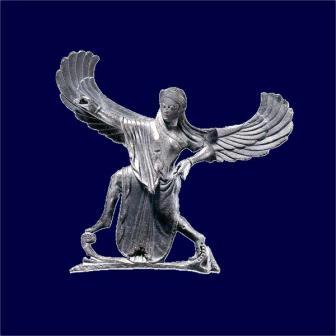
Bronze Image of Nike from the 6th Century BCE
To
Dance With Angels
The Greek Nike image is the basis for the
winged sculpture of Victory on the prow of a ship which is on
display in the Louvre in Paris France.

Victory, "Nike" Classical Greek Statue
550 BC
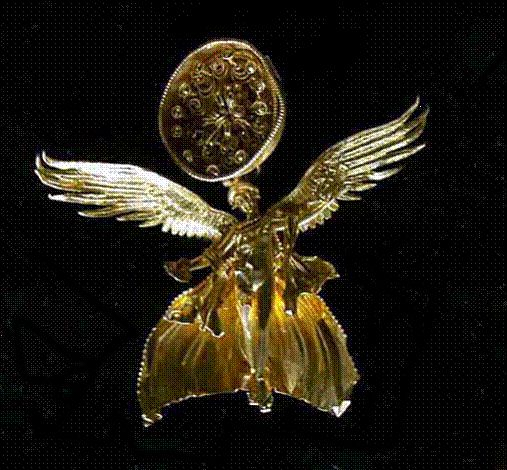
Hellenistic Greek (Angel) Nike
To Dance
With Angels

Greek Winged Figure Earring 330-300 BC
The sculptural image of the Classical/Hellenistic Greek winged
Goddess Nike and her son Eros remain the historic and classical
basis for Christian angel iconography used from the 1st century
AD until modern times, having changed little over the last 2600
years. These Christian Icons, angels and cherubim, had their
Greek and Roman counterparts before the Christan Era. The Greek
and Roman tradition in the portrayal and use of the Nike/Victory
icon were at least 6oo years old by the time Nike/victory was
adopted by the Byzantine Church as the standard depiction of
an angel.
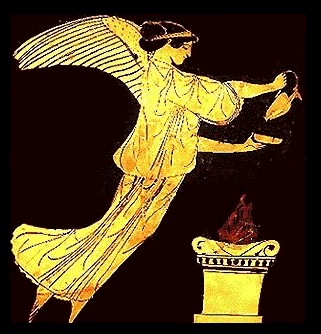
Greek Nike Image from Attic Pottery 550 BCE
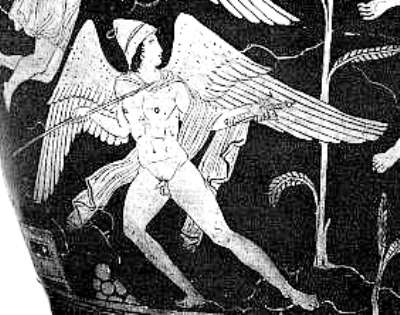
Attic Pottery Angel 4-5th century BCE
It may be surprising that the Hebrew culture
is not the primary source of the modern standard for angel imagery
but that the modern concepts are primarily Greek in their origins
and those concepts were derived from earlier Egyptian influences.
The Hebrews emphasis on an iconoclastic approach to their worship
seems to have preempted making sculptural and artistic representations
of angels within their culture. The Greeks on the other hand had
no such limitations placed on their artistic expression.

Angels of Death 515 BC Greek Krater
The Nike iconographic theme was repeated in the
Roman Culture as the winged Goddess Victory and was prominent
throughout the Roman Culture. My favorite example of this theme
in Roman sculpture is the personal portrait of Augustus the absolute
ruler of Rome from 3o BCE- 14 CE. Both the Roman version of Nike
and Eros were prominantly used in the art depicting the divine
rulership of Augustus Ceasar.
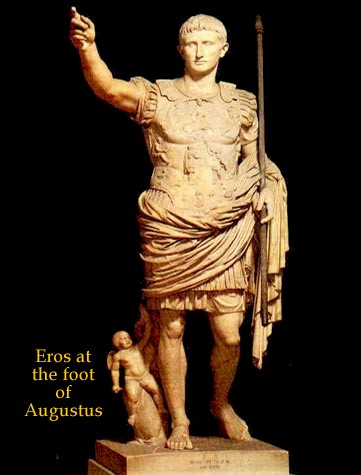
Example of the use of an angel
image in the Roman Culture
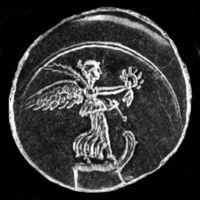 
Victory holding a palm frond and laurel wreath
Octavian/Augustus- AR denarius, 29-27 B.C. But both the obverse
and
reverse of this coin feature types celebrating Octavian's
victory over Antony and Cleopatra.

Augustus Gold Victory Coin
See: AUGUSTUS SAINT-GAUDENS Victory proceeding General Sherman
1903
Another example of the roman use
of the classical greek image of Nike/Victory is the illustration
of Tiberius Caesar with Victory depicted in the upper lefthand
corner of the cameo. This celebration of triumph and crucifixion
of his enemies is the closest image to the crucifixion of Christ
that the romans made for themselves. Although the men being crucified
and the families being humiliated are enemy soldiers the techniques
and attitudes toward their enemies is uniquely Roman within the
first century CE. The image of Victory is common in connection
with triumphs and their commemoration and depictions in Roman
art, a cannon and standard for the historic time frame.

Tiberius celebrating a Victory with his family Roman 1st century
CE ,
An image of Victory can bee seen in the upper left hand corner
to the rear.
The early Christian Church, particularly
the Byzantine Church between 400
AD and 600 AD, was responsible for adapting and transmuting the
Greek and Roman goddess imagery into the lexicon of Christian
iconographies in angel art. It is my personal opinion that the
development of Byzantine Angel Iconography was one of the most
creative periods within the history of angel art bringing many
new visual interpretations of angels to the forefront. For example
the Iconographic development of the six winged angel image of
the seraphim can be dated to the Byzantine period as well as many
other imaginative adaptations.
This image of multiple winged human
figures was not without precedent the idea was illustrated in
Egypt as early as the 15th century BC and in Mesopotamia in the
9the century BC.

Seraphim Mosaic from Greek Orthodox Church

Seraphim Sculpture Anglican
Church 18th Century England
Adapted from the Byzantine tradition
During the European middle ages of 1100-1500
AD angel imagery changed little from its Byzantine origins except
for the individual artists style and talent. During the middle
ages the literary context of the European culture became replete
with angel lore in which stories about both Light and Dark Angels
became the explanations for almost every natural phenomenon.

Russian Orthodox Church 16th Century
The Italian Renaissance saw the improvement of
artistic techniques and the resurrection of lost art forms and
classical themes particularly in sculpture but the basic angel
images changed little from their Hellenistic Greek forms. Renaissance
Italy was firmly implanted with the Greek and Roman influences
in its preferences for its artistic imagery. This historic period
was marked with a dramatic renewal in the arts and the application
of the basic sciences and scientific procedures. The primary source
for these influences were the Greek and Roman ancient world.
The die was cast for the conventions of Angel
Iconography in the hellenistic Greek period and these remained
consistent for hundreds of years and now for several millennia.
The Baroque and Rococo periods of art found the heaven on earth
theme taken to new levels of richness and complexity. This trend
ended to a large degree with the humanistic French Revolution
but continued to some degree until the early 20th century.
.
"Heaven on Earth"
theme as developed
in 16th Century Toledo Spain, this theme was heightened
and further developed in the Baroque and Rococo traditions.
A distinct departure from the Gothic style of medieval Europe
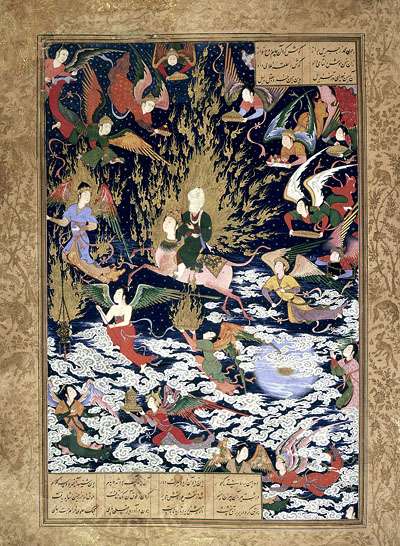
The ascension of the Prophet Muhammad
to heaven from 16th century Iran
In Islamic tradition from at least the 14th
century, the Buraq myth, combines elements of ancient depictions
of griffins, sphinxes, and centaurs, as well as angels and became
a favorite subject of Persian miniature painting. The story
is of the ascension of the Prophet Muhammad to heaven. The mythological
creature called the Buraq was depicted as Muhammad's means of
access into heaven.
| Victory Medals celebrating
the victories of Welington in the battles of Vitoria (1813)
and Waterloo (1815) |
Yoshitoshi Taiso, 1839-1892
ghost of Sasaki Kiyotaka
from the series "Tsuki Hyakushi"
Not to be ignored are the Japanese artists
who illustrated both benevolent and evil spirits in their art.
The Japanese had a wonderful and matter of fact relationship
with the spiritual world and this is reflected in their mythology
and literature. One of the most poignant of these images is
from the series "Tsuki Hyakushi" (One Hundred Aspects
of the Moon) the maiden Iga-no-Tsubone encounters the ghost
of Sasaki Kiyotaka. Walking the world as a troubled spirit he
complained to her that he had been accused of conducting an
ill fated military campaign and was forced to commit suicide.
Tsubone calmly appeased him and he never appeared to her again.
This encounter is illustrated in a way that is both beautiful
and dramatic, one of the best designs of the One Hundred Aspects
of the Moon series.

The Sherman Monument was AUGUSTUS SAINT-GAUDENS
largest and most technically demanding project
installed 1903 in Central Park New York city
The romantic and Victorian Era created some
of the most ostentatious contributions to the visions of angels
with Queen Victoria's memorial, nothing has been done since
that compares to her's and prince Albert's memorial.
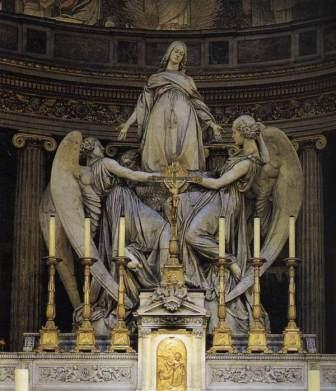
The height of Romantic visions is represented
by the Ascension of Mary Magdalene in the Church of the
Magdalene in Paris France. Created by Carlos Marochetti
who also did the facade on the Arc de Triumph and queen
Victoria's Memorial all prominently featuring romanticized
angel images.

Queen Victoria's Memorial erected 1911
The trend toward the ostentatious mostly ended
with the humanistic French Revolution and the introduction of
more scientific paradigms of thinking. However the Victorian
era proved once again that you can flaunt it if you have it
regardless of good taste and common sense.
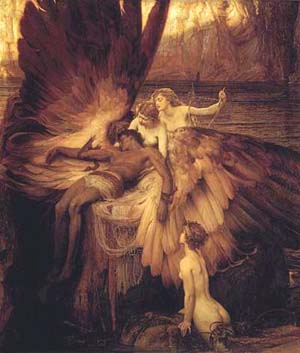
Romantic imagery from 19th century artist
Herbert James Draper "The Lament to Icarus"
Upon examination little changed in basic angel
iconography during the period from Hellenistic Greek representations
of Nike to the Romantic Era except for the wider application of
the basic visual concepts to additional literary and religious
themes. The basic concept was used in all subsequent periods of
European Art. This trend continued and found the reconstituted
classical image applied to interests in mythological, historic
and Biblical themes. The imagery was nearly universally accepted
and applied by different artists according to local tastes and
individual style. However the accepted concept of what represents
an angel had its roots with the Hellenistic Greeks and has had
a run of popular acceptance for an amazing 2500 years.
Some of the World War
I Victory Medals Issued by the Allied nations
WW I was called the war to save civilization
To
Dance With Angels |

Anselm Kiefer's Book with Wings (1994)
Collection of the Fort Worth Museum of Modern art

This image is to help you judge scale
To
Dance With Angels
In conclusion:
Although the basic angel image, a winged human
figure, has undergone the transmutations and changes of culture,
context, language, religion, literature and commercialization
for the singular sake of selling feminine lingerie, through six
millennia of human history the visual effect of this concep remains
consistent through time. The winged human figure still has the
power to create wonder, awe and inspiration, which is an extraordinary
and valuable testament to the universal and timeless appeal and
power of the visual arts.

Victoria's Secrets Commercial use of the
Angel Image for the promotion
and sale of their lingerie is less than forgettable.
The earliest beginnings of winged human figures started even
before the Osiris myth and with the Osiris Myth and the Egyptian
book of the dead have lasted an incredible 6000 years of the
human experience. The nike/victory/Christian Angel image is
a relative newcomer and is firmly imbedded in the western cultures
influenced by the Greek and the Romantic languages. . This imagery
is approaching its 27ooth birthday a mere child compared to
the Egyptian record.
As we enter the new Millennium, with an understanding of relativity
and as science pushes back the edges of time and the known Cosmos
with deep space telescopes it may be prudent to suggest a greater
paradigm for the perception of an angel image. As our ancestors
drew inspiration from nature and their know universe for the
creation of goddess and angel images, with a little imagination
it is easy connect the dots and to find the image of a "Goddess
of the night sky" (Nut) , a "Nike", a "Winged
Victory", an "Icarus" or an "Arch Angel"
in the cosmic dust and stars of the Orion nebula M42_43 where
universes and planetary systems, similar to that of our own
sun, are currently being born.
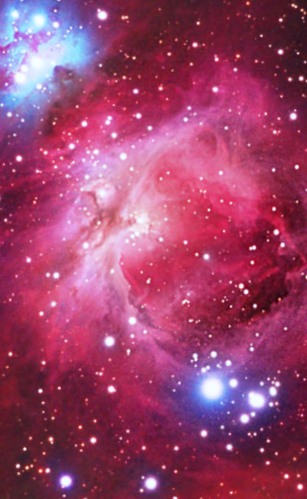
Star Dust Angel in the Orion nebulas M43-M42

Comet Hale Bopp illustrates
how comets may have
been a significant inspiration for the Egyptian winged goddesses
and the Greek concept of Nike. In the ancient world comets
were considered to be messengers and portents of important events.
To
Dance With Angels
|


